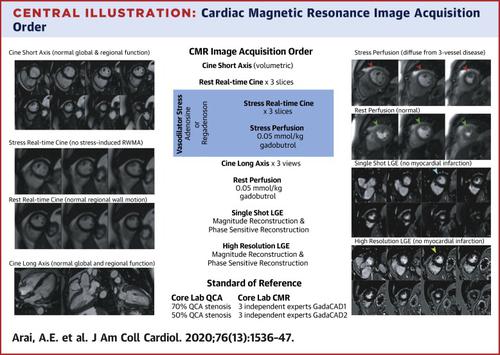当前位置:
X-MOL 学术
›
J. Am. Coll. Cardiol.
›
论文详情
Our official English website, www.x-mol.net, welcomes your
feedback! (Note: you will need to create a separate account there.)
Gadobutrol-Enhanced Cardiac Magnetic Resonance Imaging for Detection of Coronary Artery Disease
Journal of the American College of Cardiology ( IF 21.7 ) Pub Date : 2020-09-01 , DOI: 10.1016/j.jacc.2020.07.060 Andrew E Arai 1 , Jeanette Schulz-Menger 2 , Daniel Berman 3 , Heiko Mahrholdt 4 , Yuchi Han 5 , W Patricia Bandettini 1 , Matthias Gutberlet 6 , Arun Abraham 7 , Pamela K Woodard 8 , Joseph B Selvanayagam 9 , Gerry P McCann 10 , Christian Hamilton-Craig 11 , U Joseph Schoepf 12 , Ru San Tan 13 , Christopher M Kramer 14 , Matthias G Friedrich 15 , Daniel Haverstock 16 , Zheyu Liu 16 , Guenther Brueggenwerth 17 , Claudia Bacher-Stier 17 , Marta Santiuste 16 , Dudley J Pennell 18 ,
Journal of the American College of Cardiology ( IF 21.7 ) Pub Date : 2020-09-01 , DOI: 10.1016/j.jacc.2020.07.060 Andrew E Arai 1 , Jeanette Schulz-Menger 2 , Daniel Berman 3 , Heiko Mahrholdt 4 , Yuchi Han 5 , W Patricia Bandettini 1 , Matthias Gutberlet 6 , Arun Abraham 7 , Pamela K Woodard 8 , Joseph B Selvanayagam 9 , Gerry P McCann 10 , Christian Hamilton-Craig 11 , U Joseph Schoepf 12 , Ru San Tan 13 , Christopher M Kramer 14 , Matthias G Friedrich 15 , Daniel Haverstock 16 , Zheyu Liu 16 , Guenther Brueggenwerth 17 , Claudia Bacher-Stier 17 , Marta Santiuste 16 , Dudley J Pennell 18 ,
Affiliation

|
BACKGROUND
Gadolinium-based contrast agents were not approved in the United States for detecting coronary artery disease (CAD) prior to the current studies. OBJECTIVES
The purpose of this study was to determine the sensitivity and specificity of gadobutrol for detection of CAD by assessing myocardial perfusion and late gadolinium enhancement (LGE) imaging. METHODS
Two international, single-vendor, phase 3 clinical trials of near identical design, "GadaCAD1" and "GadaCAD2," were performed. Cardiovascular magnetic resonance (CMR) included gadobutrol-enhanced first-pass vasodilator stress and rest perfusion followed by LGE imaging. CAD was defined by quantitative coronary angiography (QCA) but computed tomography coronary angiography could exclude significant CAD. RESULTS
Because the design and results for GadaCAD1 (n = 376) and GadaCAD2 (n = 388) were very similar, results were summarized as a fixed-effect meta-analysis (n = 764). The prevalence of CAD was 27.8% defined by a ≥70% QCA stenosis. For detection of a ≥70% QCA stenosis, the sensitivity of CMR was 78.9%, specificity was 86.8%, and area under the curve was 0.871. The sensitivity and specificity for multivessel CAD was 87.4% and 73.0%. For detection of a 50% QCA stenosis, sensitivity was 64.6% and specificity was 86.6%. The optimal threshold for detecting CAD was a ≥67% QCA stenosis in GadaCAD1 and ≥63% QCA stenosis in GadaCAD2. CONCLUSIONS
Vasodilator stress and rest myocardial perfusion CMR and LGE imaging had high diagnostic accuracy for CAD in 2 phase 3 clinical trials. These findings supported the U.S. Food and Drug Administration approval of gadobutrol-enhanced CMR (0.1 mmol/kg) to assess myocardial perfusion and LGE in adult patients with known or suspected CAD.
中文翻译:

用于检测冠状动脉疾病的钆布醇增强型心脏磁共振成像
背景 在目前的研究之前,基于钆的造影剂在美国未被批准用于检测冠状动脉疾病 (CAD)。目的 本研究的目的是通过评估心肌灌注和晚期钆增强 (LGE) 成像来确定钆布醇检测 CAD 的敏感性和特异性。方法 进行了两个设计几乎相同的国际、单一供应商、3 期临床试验,“GadaCAD1”和“GadaCAD2”。心血管磁共振 (CMR) 包括钆布醇增强的首过血管舒张压力和静息灌注,然后是 LGE 成像。CAD 由定量冠状动脉造影 (QCA) 定义,但计算机断层扫描冠状动脉造影可以排除显着的 CAD。结果 由于 GadaCAD1 (n = 376) 和 GadaCAD2 (n = 388) 的设计和结果非常相似,因此将结果总结为固定效应荟萃分析 (n = 764)。CAD 的患病率为 27.8%,定义为≥70% QCA 狭窄。对于≥70% QCA 狭窄的检测,CMR 的敏感性为 78.9%,特异性为 86.8%,曲线下面积为 0.871。多支血管 CAD 的敏感性和特异性分别为 87.4% 和 73.0%。对于 50% QCA 狭窄的检测,灵敏度为 64.6%,特异性为 86.6%。检测 CAD 的最佳阈值是 GadaCAD1 中 QCA 狭窄≥67% 和 GadaCAD2 中 QCA 狭窄≥63%。结论 血管舒张应激和静息心肌灌注 CMR 和 LGE 成像在 2 个 3 期临床试验中对 CAD 具有很高的诊断准确性。这些发现支持美国
更新日期:2020-09-01
中文翻译:

用于检测冠状动脉疾病的钆布醇增强型心脏磁共振成像
背景 在目前的研究之前,基于钆的造影剂在美国未被批准用于检测冠状动脉疾病 (CAD)。目的 本研究的目的是通过评估心肌灌注和晚期钆增强 (LGE) 成像来确定钆布醇检测 CAD 的敏感性和特异性。方法 进行了两个设计几乎相同的国际、单一供应商、3 期临床试验,“GadaCAD1”和“GadaCAD2”。心血管磁共振 (CMR) 包括钆布醇增强的首过血管舒张压力和静息灌注,然后是 LGE 成像。CAD 由定量冠状动脉造影 (QCA) 定义,但计算机断层扫描冠状动脉造影可以排除显着的 CAD。结果 由于 GadaCAD1 (n = 376) 和 GadaCAD2 (n = 388) 的设计和结果非常相似,因此将结果总结为固定效应荟萃分析 (n = 764)。CAD 的患病率为 27.8%,定义为≥70% QCA 狭窄。对于≥70% QCA 狭窄的检测,CMR 的敏感性为 78.9%,特异性为 86.8%,曲线下面积为 0.871。多支血管 CAD 的敏感性和特异性分别为 87.4% 和 73.0%。对于 50% QCA 狭窄的检测,灵敏度为 64.6%,特异性为 86.6%。检测 CAD 的最佳阈值是 GadaCAD1 中 QCA 狭窄≥67% 和 GadaCAD2 中 QCA 狭窄≥63%。结论 血管舒张应激和静息心肌灌注 CMR 和 LGE 成像在 2 个 3 期临床试验中对 CAD 具有很高的诊断准确性。这些发现支持美国











































 京公网安备 11010802027423号
京公网安备 11010802027423号